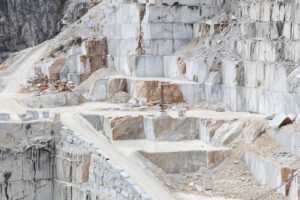
Home » Journal Articles » Thoughts & Opinions » Beginner’s Corner – Nov/Dec 2000
Question: At the recent NWSSA Symposium a term that was used regarding stone carving was the “skin” of the stone. Please explain the meaning of this term and how it applies to stone carving. Also how do you know in the process of sanding/carving of the stone that you have removed the “skin”?
Answer: In answering this question, NWSSA member Ron Geitgey had this response:
As used by carvers, skin (or crust or rind) refers to the outer surface of a stone that has some characteristic different from the interior. It may be a difference in color, hardness, mineral composition, or texture, that is, grain size and arrangement. Such alteration may be the result of surface weathering, percolation of hot or cold water along fractures, or movement along fractures (faulting) and its effects may penetrate sever al inches into the stone.
The skin may be either harder or softer than the interior. Granites contain feldspars that weather to clays, minerals considerably softer than the original feldspars. Under different chemical conditions quartz may be precipitated in pore space producing a harder outer layer. Color differences usually indicate a change in mineralogy. Basalts, as well as many other rock types, often contain iron-bearing minerals such as magnetite and pyrite, both of which alter to yellow, brown, and red iron oxides. Serpentine often exhibits slickensides, a smooth shiny surface developed as the rock fractured and moved. Flint nodules, formed in limestone, often have an outer surface, called a cortex, of softer remnant limestone. All of this is one of the main reasons a geologist uses a hammer, to break through any alteration layer to see the original rock underneath.
From a carving standpoint, markedly conspicuous skin is often incorporated as a design element, leaving areas of it intact as a contrast to the unaltered stone, as with pieces done in jade or basalt. Complete removal of the skin leaves a more uniform stone. Knowing when you have removed any skin is a matter of recognizing when the stone characteristics, usually color, have changed.
Skin is typically not encountered in freshly quarried rock unless the rock broke along altered fractures. Stream boulders, residual boulders in soil, and fractured volcanic rock frequently exhibit alteration skins.




We need some kind of descriptive text here.